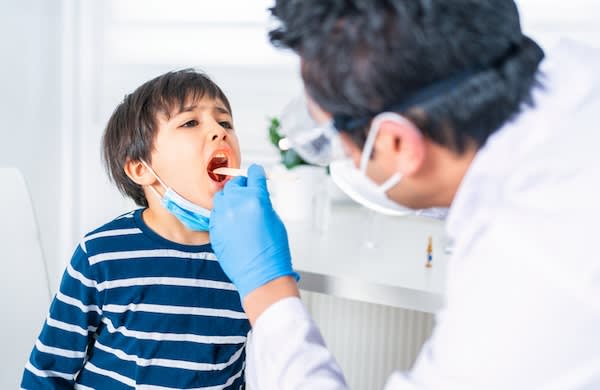
[3 MIN READ]
In this article:
-
The best way to tell if a sore throat is strep throat is by checking your child for other signs of a cold.
-
Strep throat is usually treated with antibiotics.
-
When in doubt, see your pediatrician. They will perform a strep test for your child.
Your child comes to your bedside in the middle of the night complaining of throat pain. They’re miserable, and you want to help them — but there are so many questions swirling in your head: What’s the best treatment for a sore throat? What are the symptoms of strep throat? Are they contagious? Should you keep them home from school?
“It’s really unusual for kids under 5 to have a sore throat,” says Elizabeth Meade, M.D., pediatrician and medical director of quality for pediatrics at Providence Swedish. “Unless they have a known sick contact who has strep throat, most often this is a virus or some other cause of sore throat.”
What is strep throat?
Strep throat is a bacterial infection in the throat and tonsils (the specific bacteria is called Group A Streptococcus). While anyone can get strep throat, it’s most common in children ages 5 to 15. It is most often spread through contact with another person who has strep throat, just like other bacterial infections.
The best way to treat strep throat is through antibiotics, but in recent years, people have been taking antibiotic treatments too often and building up immunity to them. That’s why it’s important to distinguish between strep throat and a sore throat.
Signs and symptoms of sore throat vs. strep
A sore throat is often the first sign of a cold, which is a viral infection. Cold symptoms include:
- Cough
- Fever
- Headache
- Muscle ache
- Runny nose
- Sneezing
- Stuffy nose
Strep throat symptoms include:
- A sore throat that started very quickly and may look red
- Fever
- Pain when swallowing or difficulty swallowing
- Red and swollen tonsils
- Swollen lymph nodes in the neck
- Tiny red spots on the roof of the mouth
- White patches or streaks of pus on the tonsils
“For kids who are over the age of 5, we really want to think about what their other symptoms are,” says Dr. Meade. “If they have a lot of cold symptoms, such as a runny nose or cough, it’s less likely to be strep and more likely to be a virus.”
On the other hand, it’s important to seek treatment if your child is truly sick with a bacterial infection. “If they have a fever, if they have a really painful throat, or their throat looks red and their tonsils look swollen when you look inside, then that’s the time you might want to get them checked out by a pediatrician,” Dr. Meade adds.
How strep throat is diagnosed and treated
When you take your child to the doctor, they will perform a rapid strep test (also known as a throat culture) for streptococcus bacteria in the throat. During the test, they use the tip of a cotton swab to rub the back of the throat, then test it right away. If the strep test is positive, they will start your child on a course of antibiotics.
Complications of strep throat
If strep throat isn’t treated, there’s a chance that the bacterial infection could spread to other parts of the body. Complications of strep throat can include:
- Ear infections
- Rheumatic fever
- Kidney disease
- Pockets of pus around the tonsils or in the neck
- Sinus infections
If you really aren’t sure and are concerned, it’s always better to be safe than sorry. Take your child to their pediatrician or to urgent care and get a strep test done right away.
Contributing caregiver

Elizabeth Meade, M.D., is pediatrician and medical director of quality for pediatrics at Providence Swedish.
Find a doctor
If you are looking for a Providence health care provider, you can search for one who’s right for you in our provider directory.
Download the Providence app
It’s all in the app: easily stay connected with Providence and your health. With the Providence app, you can schedule appointments, have virtual visits from the comfort of your own home, get health recommendations personalized for you, access your health records and so much more. Learn more and download the app.
Related resources
Stay healthy with clean hands and a flu shot
Get your child caught up on their wellness visits
Include vaccines in your back-to-school plan
This information is not intended as a substitute for professional medical care. Always follow your health care professional’s instructions.
About the Author
More Content by Providence Children's Health Team





















